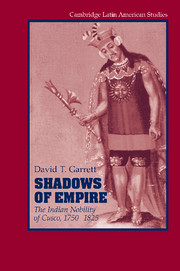Book contents
- Frontmatter
- Contents
- List of Illustrations
- Acknowledgments
- Pueblos Mentioned in Text
- Pueblos on Maps, by Province
- Introduction
- Part I INDIAN ELITES AND THE COLONIAL ORDER
- Part II THE INDIAN NOBILITY OF BOURBON CUSCO
- 3 Cacical Families and Provincial Nobilities
- 4 Communal Economies and Indian Fortunes
- 5 The Politics of the Cacicazgo
- Part III CRISIS AND COLLAPSE
- Conclusion
- Appendix
- Glossary
- Bibliography
- Index
4 - Communal Economies and Indian Fortunes
Published online by Cambridge University Press: 19 October 2009
- Frontmatter
- Contents
- List of Illustrations
- Acknowledgments
- Pueblos Mentioned in Text
- Pueblos on Maps, by Province
- Introduction
- Part I INDIAN ELITES AND THE COLONIAL ORDER
- Part II THE INDIAN NOBILITY OF BOURBON CUSCO
- 3 Cacical Families and Provincial Nobilities
- 4 Communal Economies and Indian Fortunes
- 5 The Politics of the Cacicazgo
- Part III CRISIS AND COLLAPSE
- Conclusion
- Appendix
- Glossary
- Bibliography
- Index
Summary
When Lampa's corregidor appointed Antonio Tapara as cacique of Ñuñoa Urinsaya, he articulated the cacique's three responsibilities: tribute collection, Christian rule, and good government. He started with tribute collection: he had ridden forty miles across the mountains because the earlier cacique had failed in what was, to crown officials, the cacique's central duty. What mattered most was that twice a year the cacique collected his community's tribute and delivered it to the corregidor (and, in mita areas, that he delivered his corvees). This was no easy task. Many tributaries were reluctant to pay; others fled or died, leaving the cacique to cover the shortfall. Moreover, in many areas tributaries lacked access to cash. A complex market tied together the highland cities, but barely penetrated Indian pueblos. Caciques often had to convert their tributaries' labor or produce into cash for tribute, which allowed caciques to dominate local economies, making them the nexus between the community and the colonial market. Caciques also enjoyed usufruct of communal land and used their personal wealth to dominate capital-intensive factors of production in their communities.
Cacical houses were thus by far the richest segment of Indian society. Not all accumulated wealth: the obligation for communal debts made the cacicazgo a perilous position. But successful caciques funneled the profits of office into private wealth. This created a structural conflict between communities and a cacical elite committed to familial property, and historians have argued that cacical wealth produced class stratification, and conflict, in the colonial pueblo. At the same time, the foundation of cacical wealth remained in control of the communal economy.
- Type
- Chapter
- Information
- Shadows of EmpireThe Indian Nobility of Cusco, 1750–1825, pp. 114 - 147Publisher: Cambridge University PressPrint publication year: 2005



